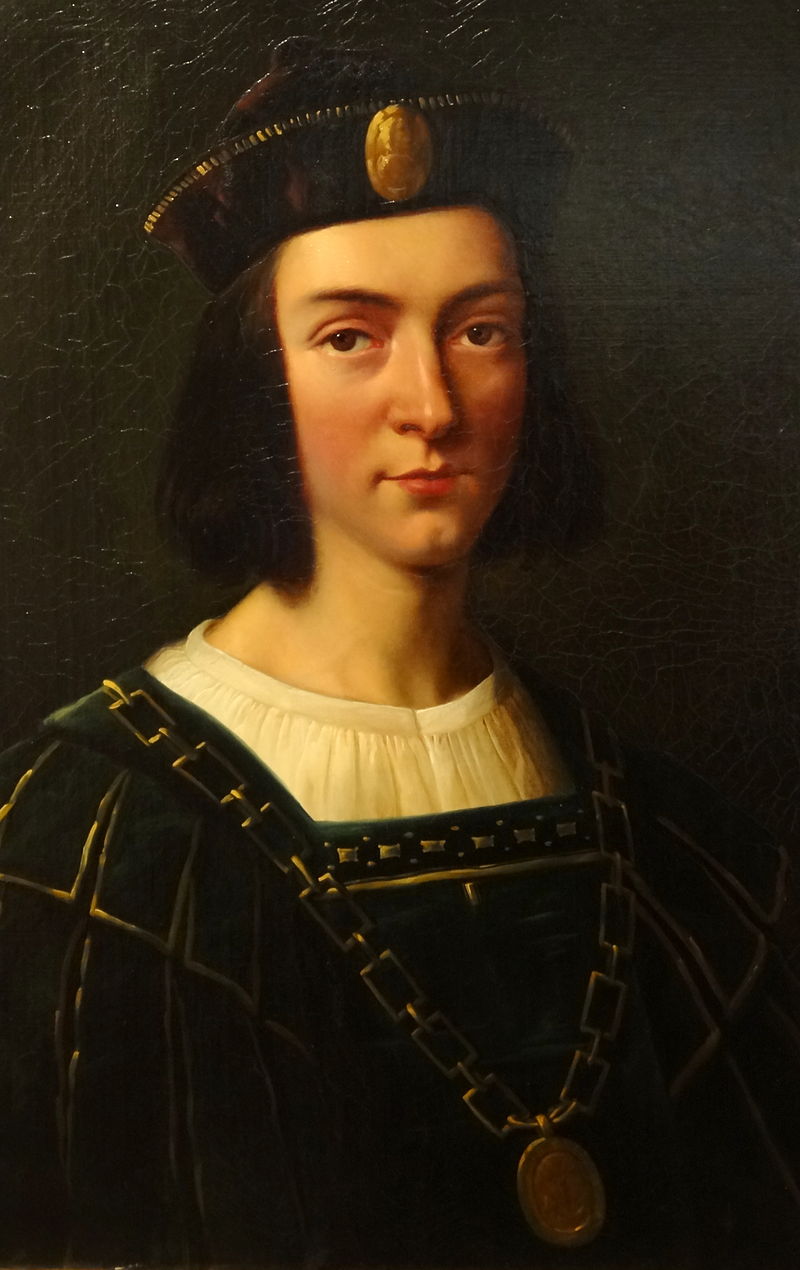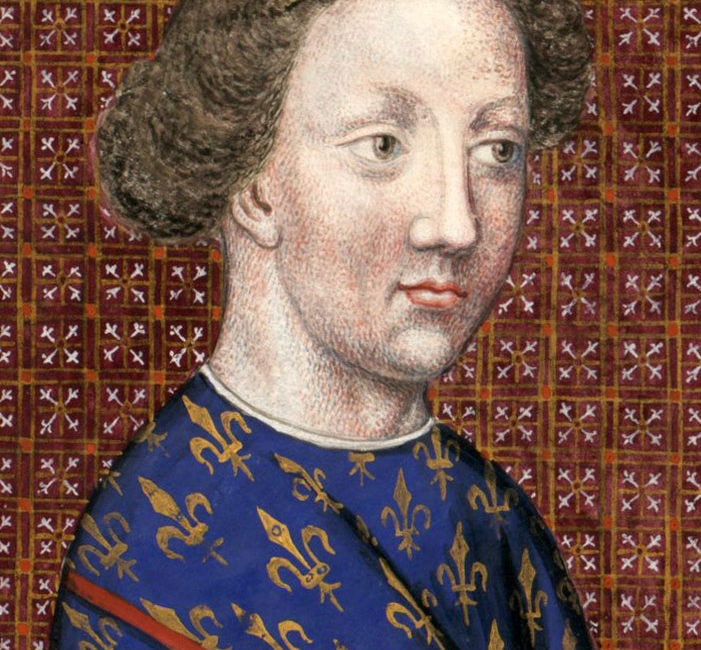Louis II, Duke de Bourbon, called the Good (le Bon) was a prince du sang (a prince of the blood). He was the oldest son of Duke Pierre I de Bourbon, and his spouse, Princess Isabelle de Valois, who was the sister of King Philippe VI the Fortunate (le Fortuné). Louis’ father died at the Battle of Poitiers of 1356, and then Isabelle took the veil. Bourbon’s sister, Jeanne de Bourbon, was married to King Charles V of France the Wise (le Sage), so King Charles VI of France the Mad (le Fou) and his young brother – Louis I, Duke d’Orléans – were his nephews.


The senior Bourbon line was descended from Robert, Count de Clermont (1256-1317), who was son of King Louis IX of France known as Saint Louis and his consort, Marguerite de Provence. Robert’s oldest son – Duke Louis I called the Lame (le Boiteux) – was somewhat mentally unstable, which became a hereditary trait of the Bourbon family. Queen Jeanne de Bourbon is reported to have had several nervous breakdowns, and she passed her mental issues on to her son – King Charles VI. Duke Louis II also suffered from nervous breakdowns.
Despite his health issues, Louis II de Bourbon was active in politics and wars. In his youth, he was a loyal subject to King Jean II of France (le Bon). After the disastrous Battle of Poitiers, Bourbon was sent to England among many nobles to be hostage for the payment of ransom for King Jean. Bourbon returned home only in 1367 during the reign of Charles V, his brother-in-law. Bourbon proved himself as a competent commander: in 1368-1370, he led the royal armies in Poitou and Guyenne against the English during the re-conquest of the lands which had years ago been captured by Edward III of England or which had been lost according to the Treaty of Brétigny of 1360. It greatly extended the Plantagenet domains in southwestern France.
Duke Louis followed the recommendations of the Constable of France Bertrand du Guesclin nicknamed ‘The Eagle of Brittany’ (l’Aigle de la Bretagne). The main strategy was to avoid open and massive battles with the English until the French could achieve sufficient advantage. Acting like this, Bourbon started skirmishes, and over time, he took many strongholds in Limousin, Britany, and Guyenne. In 1371, he captured Limoges together with Duke Jean de Berry, Charles V’s brother. In 1374, Louis captured the strongholds in Rouergue, Poitou, and Touraine. With the monarch’s another brother, Duke Louis I d’Anjou, Bourbon re-captured Bigorre and La Réole.
Afterwards, Bourbon fought against the bands of routiers (mercenaries in the Middle Ages) in his duchy. In the second half of the 1370s, Charles V sent him to Normandy to fight against King Charles of Navarre the Bad (le Mauvais), where Bourbon captured some strongholds. During the minority of King Charles VI, Bourbon was a member of Regency Council. Years later, when his nephew began drifting in and out of his psychotic trances starting from 1392, Bourbon played an important role in politics. In the mid-1380s, he again fought against the English in Guyenne. In 1390, he departed from Genoa to Tunisia on the siege of Carthage.


During the reign of Charles VI the Mad, the French princes of the blood competed fiercely for access to the royal treasury and for power. For a long time, Philippe the Bold (le Hardi), Duke of Burgundy, was the effective ruler of France, negotiating the extensions of peace treaty with England and slowly creating his strong Burgundy, sadly, at the expense of France. Gradually, Bourbon’s nephew – Louis de Valois, Duke d’Orléans – was building his powerbase. Bourbon took the side of Louis d’Orléans at first against Philippe the Bold and then against Jean the Fearless (Sans Peur). After Philippe the Bold’s death in 1404, the struggle for power between Louis d’Orléans and Jean the Fearless intensified, and Bourbon supported his nephew.
The barbaric murder of the Duke d’Orléans on the 23rd of November 1407 on Rue Vieille-du-Temple in Paris shocked everyone. The Burgundians nevertheless earned the sympathies of the Parisians by promising to lower taxes, which was not later done. Jean the Fearless was very skilled at manipulating the people, which helped him gain the love of many in northern France. Bourbon was bereft because of his nephew’s assassination and returned to his estates. His oldest son – Count Jean de Clermont – was a staunch supporter of the Orléanist faction, which transformed into the Armagnacs after the wedding of Duke Charles d’Orléans (Louis d’Orléans’ eldest son) to Bonne d’Armagnac, who was daughter of Count Bernard d’Armagnac and his wife, Bonne de Berry.
Louis de Bourbon did not join the civil war. “You are a fool,” he told the emissary of Charles d’Orléans who came to his estates to invite him to join their cause. “You cannot imagine what it is to embark upon a civil war. These things are quickly begun, but they are slow to heal.”
Duke Louis II de Bourbon passed away in his estates at Montluçon at the age of 72-73 on the 10th of August 1410. His spouse was Anne d’Auvergne, Countess de Forez and daughter of Béraud II, Dauphin d’Auvergne. Out of their four children, only two survived: Jean de Bourbon and Isabelle de Bourbon. During the Armagnac-Burgundian civil war, Jean de Bourbon took sides against the Burgundians; later he was captured at the Battle of Agincourt of 1415. Duke Louis was interred in Souvigny Priory in the commune of Souvigny, Allier, France, in the old province of the Bourbonnais. His wife, Anne, was buried alongside her husband when she died in 1417.
Duke Louis II de Bourbon had notebale discendants. Among them:
- Charles II, Count de Montpensier, de Clermont, and d’Auvergne, who was killed in the Sack of Rome of 1527. His father, Gilbert Count de Montpensier, was Louis’ great-great-grandson.
- Suzanne de Bourbon, suo jure Duchess de Bourbon, through Louis’ great-grandson Pierre de Bourbon, Duke de Bourbon, who was married to Anne de France, Madame la Grande.
- Mary/Marie the Rich and her son – Philip the Handsome from the House of Habsburg, through Louis’ granddaughter – Isabelle de Bourbon who married Charles the Bold (le Téméraire), Duke of Burgundy.
- Through Philip the Handsome, Emperor Charles V and Emperor Ferdinand I, as well as all future Habsburgs, through Louis’ Isabelle de Bourbon and her daughter, Mary the Rich.
- Louise de Savoy through Louis’ granddaughter, Marguerite de Bourbon, who married Philippe II the Landless (les Sans Terre), Duke de Savoy.
- Through their mother Louise de Savoy, King François I of France, the founder of the French Renaissance, and Marguerite d’Angoulême, also known as Queen Marguerite de Navarre.
- Duke Antoine de Lorraine, as well as Duke Claude de Guise, and Cardinal Jean de Lorraine and the future Dukes of Lorraine, through Bourbon’s great-granddaughter, Catherine de Bourbon.
Such analysis helps us understand how closely interconnected aristocrats, especially related to the royal dynasties, were in the Middle Ages and in the Renaissance. Some descendants of Louis II de Bourbon displayed hereditary mental issues carried through the Bourbon blood.
All images are in the public domain.
Text © 2021 Olivia Longueville





